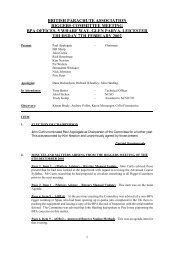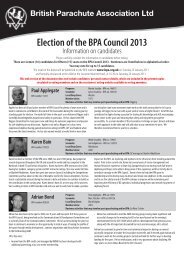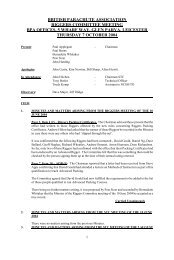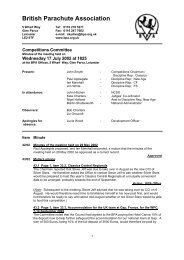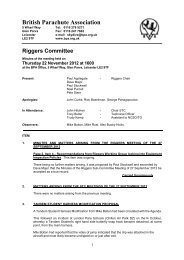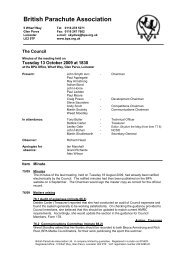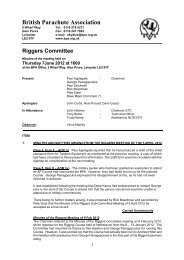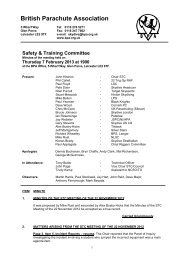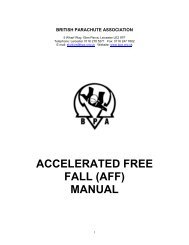August - British Parachute Association
August - British Parachute Association
August - British Parachute Association
Create successful ePaper yourself
Turn your PDF publications into a flip-book with our unique Google optimized e-Paper software.
<strong>British</strong> <strong>Parachute</strong> <strong>Association</strong><br />
5 Wharf Way Tel: 0116 278 5271<br />
Glen Parva Fax: 0116 247 7662<br />
Leicester LE2 9TF e-mail: skydive@bpa.org.uk<br />
www.bpa.org.uk<br />
STC COMMITTEE<br />
Minutes of the meeting held on<br />
Thursday 5 <strong>August</strong> 2010 at 1900<br />
at the BPA Office, 5 Wharf Way, Glen Parva, Leicester LE2 9TF<br />
Present: John Hitchen - Chairman STC<br />
John Page - Skydive London<br />
Pete Sizer - Headcorn<br />
Paul Hollow - Target Skysports<br />
Richard Wheatley - BPS, Langar<br />
Steve Scott - Skydive Weston<br />
Ray Armstrong - Skydive GB<br />
Jason Thompson - UK Para (Beccles)<br />
Chris McCann - UK Para (Sibson)<br />
Mike Rust - NLPC<br />
Matty Holford - Silver Stars<br />
Alex Busby - Tilstock<br />
Paul Applegate - Chairman Riggers<br />
Apologies:<br />
Nigel Allen, George McGuinness, Andy Clark, Dave Wood,<br />
Andy Goodall, Kieran Brady, Jason Farrant, Stuart Meacock.<br />
In Attendance: Tony Butler - Technical Officer<br />
Trudy Kemp - Assistant to NCSO/TO<br />
Observers:<br />
Damian Hewitt, Jez Shazell, Dave Major, Colin Fitzmaurice,<br />
Rick Boardman, Instructor A.<br />
ITEM<br />
MINUTE<br />
1. MINUTES OF THE STC MEETING OF THE 10 JUNE 2010<br />
It was proposed by Matty Holford and seconded by Richard Wheatley that the Minutes of the<br />
STC Meeting of the 10 June 2010 be accepted as a true record.<br />
Carried Unanimously<br />
2. MATTERS ARISING FROM THE STC MEETING OF THE 10 JUNE 2010<br />
Page 1, Item 2, Matters Arising – Incident Reports. The Chairman reported that Kieran<br />
Brady the Chairman of the Working Group looking into the qualifications and training of pilots<br />
flying foreign registered aircraft had sent a letter to CCIs and CCPs following the last STC<br />
requesting input. He stated that so far there had been very little response, but it was hoped<br />
that the Working Group would have some proposals in the near future.<br />
Page 2, Item 2, Matters Arising – Proposed Changes to the BPA Operations Manual.<br />
The TO reported that at the last STC the meeting was advised that the <strong>British</strong> Citizen who had<br />
a foreign Tandem rating, had been permitted to be evaluated under the previous rules. The<br />
TO advised those present that he had since informed the person concerned that he had up to<br />
six months in which to be evaluated.<br />
1
The TO stated that in his opinion he believed there needed to be a specific time limit on this in<br />
the same way that Instructors, Riggers Packers etc had to renew their annual ratings. He<br />
asked STC if they had any objection to this. There was no objection raised by those present.<br />
Page 2, Item 4, Fatality – Langar. The fatality report resume was a main agenda item for<br />
that evening.<br />
3. MINUTES AND MATTERS ARISING FROM THE RIGGERS’ SUB-COMMITTEE MEETING<br />
OF THE 10 JUNE 2010<br />
There being no matters arising from the previous Minutes, it was proposed by Paul Applegate<br />
and seconded by Pete Sizer that the Minutes of the Riggers’ Sub-Committee meeting of the<br />
10 June 2010 be accepted as a true record.<br />
Carried Unanimously<br />
Paul Applegate then reported on that evening’s meeting and stated that Riggers had<br />
discussed a malfunction/deployment incident where it had been found that the safety pin had<br />
punctured the main bridle, locking the pin and bridle around the closing loop, causing a pilot<br />
chute in tow type malfunction.<br />
The CCI of the Centre concerned reported that the same problem had arisen on two<br />
successive weekends to the same jumper on the same set of equipment. He stated that on<br />
the first incident the container did clear as the jumper pulled the reserve, but on the second<br />
incident it stayed in place and the jumper landed with the pilot chute in tow<br />
Paul Applegate stated that the Riggers Committee had felt that these incidents may have<br />
occurred due to a packing problem rather than a manufacturers problem. However, it had<br />
been noted that a contributing factor may be if the main container was closed without leaving<br />
enough slack in the bridle between the closing pin and the main container flaps above the pin,<br />
the closing pin could possibly pierce the bridle after the pilot chute is thrown, which could lock<br />
the container closed. This appears to occur when there was little or no slack in the bridle<br />
between where it exits the container and goes to the pin, when the pin is oriented towards to<br />
top of the container and when the bridle completely covers the pin.<br />
This problem had been noted in the USA on other equipment and they put it on their list of<br />
problems to look out for.<br />
The Committee felt that this was something that packers should be aware of and was some<br />
thing to look out for during flight line checks.<br />
4. FATALITY – BPS, LANGAR<br />
The Chairman reported that the Board of Inquiry Report Resume into the fatal accident<br />
involving Brian Laithwaite and Emma Bramley had been circulated to CCIs with the agenda.<br />
At approximately 15.00 hrs on Friday the 4 June 2010, Brian Laithwaite an FAI ‘D’ Certificate<br />
(Blue) parachutist, with 1,852 jumps and Emma Rachael Bramley, an FAI ‘C’ Certificate<br />
parachutist, with 254 jumps, boarded a Cessna 208 ‘Caravan’ aircraft operated by <strong>British</strong><br />
<strong>Parachute</strong> Schools along with twelve other parachutists; a 6-way group, which both Brian and<br />
Emma were part of, a 3-way group, a 2-way group, a solo parachutist and an instructor with a<br />
Student parachutist. Brian Laithwaite was the Jumpmaster for the lift. It was the eighth lift of<br />
the day.<br />
The aircraft climbed to approximately 13,000ft AGL. A ‘jump run’ was made over the PLA.<br />
Once the aircraft was at the Exit Point, the parachutists on board exited. First to exit were the<br />
6-way group, followed by the 3-way and the 2-way groups, after which the solo parachutist<br />
exited and finally the instructor with his Student.<br />
The 6-way group in which Brian and Emma were both part of were carrying out a FS type of<br />
jump. The freefall portion of the jump went without incident. At approximately 4,500ft AGL the<br />
2
parachutists separated and deployed their parachutes. All parachutes were open higher than<br />
2,000ft AGL and all parachutes appeared to be fully deployed. Shortly after deployment<br />
Brian’s and Emma’s parachutes were seen to collide. It appeared that Emma’s parachute<br />
initially wrapped around the lower part of Brian’s body, which caused it to collapse and<br />
become further entangled.<br />
Emma was seen to be rotating below Brian. At about this time a reserve parachute was<br />
observed to have been deployed, but did not inflate. The only fully inflated parachute to be<br />
seen was Brian’s main parachute. The other parachutes appeared to be severely entangled.<br />
Initially Brian’s main parachute was observed to be fully inflated, but was rotating. At a height<br />
of between 100-200ft AGL Brian’s parachute appeared to dive towards to ground and<br />
remained in that configuration until impact.<br />
A BPA Board of Inquiry was immediately instigated and consisted of the NCSO and Technical<br />
Officer.<br />
Brian’s main canopy was a PD Stiletto 150 and Emma was jumping a Aerodyne Pilot 150.<br />
On examination of the equipment the following was noted; Brian’s main canopy was fully<br />
deployed and was still attached to the parachute harness. It was noted that the two reserve<br />
canopies were out of their parachute containers, one fully out of its deployment bag and the<br />
other only partially out of its bag.<br />
Both Brian’s main parachute cutaway pad and reserve parachute ripcord handle were in situ<br />
and had not been activated. The steering toggles on both the main and reserve parachutes<br />
were stowed in the half brake configuration.<br />
Emma’s main canopy had been deployed and was still attached to the parachute harness, but<br />
was severely entangled with the reserve parachutes.<br />
Emma’s main parachute cutaway pad was not attached to its Velcro keeper and the Teflon<br />
cables were still within the cutaway housing, but had extracted by approximately 2 inches.<br />
The Main canopy release had not been activated. Her reserve parachute ripcord handle was<br />
missing. The steering toggles on both the main and reserve parachute were stowed in the half<br />
brake configuration.<br />
The reserve parachute that had fully extracted from its deployment bag was part of Brian’s<br />
equipment and the reserve parachute that had only partially extracted from its deployment<br />
bag was part of Emma’s.<br />
The reserve parachute bridle lines and deployment bags of both reserve parachutes were<br />
entangled around the Emma’s main parachute and the main parachute bridle line and<br />
deployment bag from Emma’s equipment had passed through the rigging lines of Brian’s<br />
reserve canopy.<br />
All parachutes excluding Brain’s main parachute were extensively entangled.<br />
All parachutes had been rigged correctly and appeared to be in an airworthy condition.<br />
The Conclusions of the Board were that both Brian and Emma made an uneventful free fall<br />
descent. They separated at approximately 4,500ft and deployed their main parachutes at a<br />
correct altitude. Brian and Emma were probably relatively close to each other when they<br />
deployed their parachutes, possibly because they may have tracked in the same direction. It<br />
is possible that as their canopies were deploying, one or both of them may inadvertently<br />
turned towards the other, which would have resulted in them converging at high speed. They<br />
may not have had time to take avoiding action, resulting in their parachutes colliding.<br />
The left side of Emma’s parachute came into contact with Brian’s legs, which resulted in<br />
Emma’s parachute wrapping around Brian’s body and becoming entangled. The impact of the<br />
collision may have caused Brian’s reserve parachute container to open and the reserve<br />
parachute to extract, which then became entangled with Emma’s main parachute and Brian’s<br />
body. At some stage Emma’s main parachute pilot-chute, bridle-line and deployment-bag<br />
passed through Brian’s reserve parachute rigging lines, adding to the entanglement.<br />
3
It is not known whether Emma was in a position to be able to cutaway her main parachute, or<br />
whether she attempted to cutaway her main parachute, but at some stage it is likely that she<br />
deployed her reserve parachute, as the reserve handle had been extracted from its keeper.<br />
Emma’s reserve parachute only partly extracted from its deployment-bag. Her reserve<br />
parachute, bridle-line and deployment-bag became entangled with her main parachute. At<br />
that time it would not have been possible for either parachutist to separate.<br />
Throughout, Brian may have been trying to communicate with Emma, as his full-face helmet<br />
visor was in the open position. However, Emma’s visor was in the closed position. She may<br />
not have been able to hear Brian.<br />
Initially, Brian’s main parachute appeared to be flying relatively well and if it had remained so,<br />
it is possible that the landing may have been survivable, though the landing would have been<br />
relatively fast and heavy, as both parachutists were suspended under one main parachute.<br />
However, at between 100-200ft AGL, Brian’s main parachute appeared to dive towards the<br />
ground, resulting in a significant increase in its descent rate, causing them to impact with he<br />
ground at high speed. This is likely to have been caused by the other entangled parachutes<br />
restricting the flying characteristics of Brian’s main parachute.<br />
The Recommendations of the Board were that parachutists be reminded that when jumping<br />
with others, the importance of good separation prior to deploying their main parachutes.<br />
It was proposed by John Page and seconded by Chris McCann that the report, including its<br />
recommendations and conclusion be accepted.<br />
Carried Unanimously<br />
The Chairman reported that the Board also believed that it was not necessary to instigate a<br />
Panel of Inquiry in this instance and therefore recommend to STC that one is not instigated.<br />
It was therefore proposed by John Page and seconded by Matty Holford that a Panel of<br />
Inquiry was not instigated on this occasion.<br />
Carried Unanimously<br />
5. INCIDENT REPORTS – RESUME<br />
a. There had been 25 Student Injury Reports received since the last STC meeting. 17<br />
male and 8 female. Two were Students who dislocated their shoulders, one possibly<br />
in freefall and the other on deployment. All of the other reports were landing injuries,<br />
the majority of which were minor.<br />
b. Since the last meeting there had been 13 Injury Reports received for FAI ‘A’<br />
Certificate parachutists or above, 10 male and 3 female.<br />
c. There had been 13 Student Malfunction/Deployment Problem Reports received since<br />
the last meeting. 12 male and 1 female.<br />
d. There had also been 38 Malfunction/Deployment Problem Reports received for FAI<br />
‘A’ Certificate parachutists or above. 35 male and 3 female.<br />
e. Since the last STC there had been 13 Tandem Injury Reports received, including an<br />
instructor who had a minor landing injury. 10 male and 3 female.<br />
f. There had also been 23 Tandem Malfunction/Deployment Problem reports received<br />
since the last meeting. Also one Tandem Student took up a ‘GoPro’ camera attached<br />
to his wrist. It was hidden under the sleeve of his jumpsuit.<br />
The Chairman reported that four reports had been received involving Tandem<br />
Instructor errors, which would be discussed, in camera, once the resume was<br />
completed.<br />
4
g. One report had been received of an AAD firing. A Category 5 parachutist may have<br />
deployed a little low. The reserve was observed to inflate after the main canopy had<br />
already deployed.<br />
h. There had been 8 reports received of ‘off landings’ at clubs.<br />
i. One report had been received of a canopy entanglement on a CF jump.<br />
j. Two reports had been received of camera helmets coming off in freefall.<br />
k. Three reports had been received of display misfires, two injuries and one where a flag<br />
prematurely deployed in freefall, without further incident.<br />
l. Two reports had been received of freefall collisions. The parachutists suffered only<br />
minor bruising.<br />
m. A report had been received of an aircraft flying down the runway at approximately 50ft<br />
shortly after a parachutist had landed. This incident had been reported to the CAA.<br />
n. There had been 4 reports received of Tandem Instructors who had made various<br />
errors.<br />
The remainder of this item was held ‘in camera’ and all observers were asked to leave<br />
the meeting.<br />
The Chairman gave the meeting details of each incident, after which CCIs discussed<br />
each one individually:<br />
i. The first incident concerned a Tandem Instructor who had carried out 40<br />
Tandem jumps. He completed the freefall part of the descent without<br />
deploying the drogue, though he thought he had deployed it. This resulted in<br />
him deploying his reserve canopy. His CCI initially grounded him and after<br />
consultation with the NCSO & TO he attended a Tandem Instructor course<br />
which was running a couple of weeks later and carried out suspended<br />
harness drills, after which he made a couple of jumps, one with a bag. This<br />
was observed by the Examiners on the course. The Tandem Instructor<br />
concerned was not present at that evening’s STC meeting.<br />
ii.<br />
The second incident concerned another Tandem Instructor with 133 Tandem<br />
descents, who also completed the freefall part of the descent without<br />
deploying the drogue, again he also thought that he had deployed it. His CCI<br />
initially grounded him and after consultation with the NCSO had him carry out<br />
extensive suspended harness drills before permitting him to carry out further<br />
Tandem descents. The Tandem Instructor concerned was not present at that<br />
evening’s STC meeting.<br />
The Chairman reported that neither of the two instructors concerned have had<br />
similar problems in the past and it was felt that in both cases these were<br />
genuine mistakes. However, all Tandem instructor courses in the future would<br />
include a ‘drogue out’ check as part of the freefall drills.<br />
Following further consideration of these two incidents by those present, it was<br />
proposed by John Page and seconded by Richard Wheatley that the Tandem<br />
Instructors concerned be sent letters by the Chairman of STC reminding them of their<br />
responsibilities, which would be kept on file so that should there be any subsequent<br />
incidents involving them, this would be taken into consideration.<br />
For: 10 Against: 0 Abstention: 1<br />
Carried<br />
5
iii.<br />
The third incident involved a Tandem Instructor (Instructor A) who had made<br />
in excess of 1000 Tandem jumps and who only hooked up his Student on<br />
one side and did not spot the error until after the canopy deployed. The<br />
instructor did not know why he made this error.<br />
The Chairman reported that over the last few years Tandem Instructor<br />
courses have included an ‘in door’ drill where the instructor checks the hooks,<br />
as well as handles, prior to exiting. He stated that the instructor concerned<br />
may have gained his rating before the revised drills were included on courses.<br />
This incident was considered at some length and many CCIs present stated<br />
that they were appalled that a Tandem Instructor could allow this to happen.<br />
Following further consideration, it was proposed by Paul Hollow and<br />
seconded by Ray Armstrong that the Tandem Instructor concerned be sent a<br />
letter by the Chairman of STC reminding him of his responsibilities, which<br />
would be kept on file and that his CCI continue to carry out remedial training<br />
with him. Should there be any other contravention of Tandem rules then he is<br />
to be immediately grounded until the matter is brought before STC.<br />
For: 10 Against: 0 Abstention: 1<br />
Carried<br />
The Chairman reported that a letter had been prepared to go to all Clubs requesting<br />
that Clubs include as part of their written procedures the drills/checks to be carried<br />
out prior to moving to the door and in the door of the aircraft and also in freefall. A<br />
copy of the draft letter was circulated to those present. The TO stated that it had also<br />
been suggested that instructors may wish to consider having their Students physically<br />
check that they have been attached, much in the same way that static line Students<br />
check their static lines once they are in the aircraft. The TO and NCSO believe that<br />
these drills should be part of every Tandem Instructors drills.<br />
The Chairman asked the Committee if they had any objection to this letter being<br />
circulated to CCIs. There was no objection raised by those present.<br />
iv.<br />
The fourth incident involved a Tandem Instructor whose AAD had not been<br />
switched on prior to carrying out a Tandem descent. This was also not<br />
picked up on the flight line.<br />
The Tandem Instructor who was also a CCI was present at the meeting<br />
explained what procedures the Centre had now put in place to try to ensue<br />
that this does not happen again.<br />
The Chairman reported that since this incident, himself and the TO had<br />
watched various Tandem Instructors on flight lines being checked and some<br />
get a full flight line check, yet others only get asked if their AAD is on. He<br />
stated that it was their belief that the intention was that all Tandem Instructors<br />
should have a full flight line check including a visual check of their AADs.<br />
They believe that as they are attached to a Student, an independent check<br />
should take place. Therefore it was their intention to propose, at the next STC<br />
meeting, that this is included in the Operations Manual<br />
The Tandem Instructor concerned was asked to leave the meeting room to<br />
enable STC to consider this matter further.<br />
Following further consideration of this matter, was proposed by Matty Holford<br />
and seconded by Jason Thompson that the Tandem Instructor concerned be<br />
sent a letter reminding him of his responsibilities, which would be kept on file<br />
so if there are any subsequent incidents involving him this matter would be<br />
taken into consideration.<br />
Carried Unanimously<br />
6
The CCI concerned was invited to return to the meeting where they were advised of<br />
STC’s decision concerning him.<br />
Instructor A was then asked to return to the meeting where they were also advised of<br />
STC’s decision concerning him.<br />
The meeting then resumed in open session.<br />
6. EQUIPMENT LIFING<br />
Rick Boardman of the Riggers Committee had been chairing a Working Group looking into the<br />
Lifing of Parachuting Equipment. He was present that evening to make a presentation to the<br />
Committee on the progress the Working Group had made so far.<br />
Rick Boardman reported that the long term intention of the Working Group remained that of<br />
coming up with a more robust policy with which to equip our members, and to try to enhance<br />
the protection from litigation which a Packer or Rigger should be getting from the BPA<br />
regulations they work to. He stated that the Working Group had met frequently over the past<br />
year and had received input from parachute manufacturers in regard to their lifing/warrantee<br />
policies as well as input from Riggers, Packers, CCIs etc. and other various sources.<br />
Rick Boardman advised those present that the Working Group had decided at the meeting<br />
held that afternoon that the project would no longer be referred to as equipment lifing, but<br />
would in the future be referred to as ‘Inspection Policies’. He reported that the Working Group<br />
was considering looking to a policy where the responsibility is split across the ratings. For<br />
Student & Tandem Equipment – if the equipment was less than 10 years old then an<br />
Advanced Packer would undertake the inspection. For equipment older than 10 years old,<br />
then the responsibility moves to a <strong>Parachute</strong> Rigger and for equipment over 20 years old then<br />
an Advanced Rigger would undertake the inspection.<br />
For other licensed parachutist’s equipment (not student or tandem), again the Working Group<br />
were also looking at splitting responsibility across the ratings. For equipment less than 15<br />
years old an Advanced Packer would undertake the inspection. For equipment over 15 years<br />
old a <strong>Parachute</strong> Rigger would become involved. If over 25 years old then an AR would be<br />
required to undertake the inspection.<br />
The Working Group are also considering whether or not inspections (on the older systems)<br />
should be checked and countersigned by the relevant higher ratings, as well as the AP doing<br />
the job, or actually only carried out by those with higher ratings.<br />
Rick stated that at the moment there was very little in the BPA Advanced Packing Syllabus<br />
regarding lifing of equipment, and this was another area, which the Working Group would be<br />
addressing.<br />
Rick Boardman stated that the Working Group were still a long way off from making any firm<br />
proposals as yet, and considered the project to be a work in progress and invited input from<br />
CCIs.<br />
The reaction from members present was generally positive. Rick was able to clarify a number<br />
of points raised by the Committee in relation to the project.<br />
The Chairman expressed his thanks for Rick Boardman for his presentation that evening.<br />
7. INSTRUCTOR COURSES<br />
a. The <strong>Association</strong> wished to thank UK Parachuting (Beccles) for hosting the AFF,<br />
Tandem & Pre-Advanced Instructor Assessment Course, which took place from the<br />
28 – 30 June. The course report had been circulated with the agenda and was for<br />
information only.<br />
b. There had also been a Tandem & Pre-Advanced Instructor Assessment Course that<br />
had taken place that week at Skydive Weston, which was now completed. The<br />
7
<strong>Association</strong> was grateful to the club hosting the course. A copy of the course report<br />
was circulated to those present and was for information only.<br />
8. PERMISSIONS<br />
A letter from John Page had been circulated with the agenda requesting that Ash Booth be<br />
reinstated as Category System Basic Instructor for a period of 1 year. Mr Page’s letter had<br />
stated that due to military commitments Ash had been unable to attend a CSI course prior to<br />
his CSBI rating expiring on the 31 May 2008. Despite the time period that has elapsed since<br />
the expiry of his CSBI rating Ash had been working with the Freefall Training Flight so has<br />
been constantly training parachutists in this time. Mr Page was able to provide further details<br />
of this request.<br />
Following some discussion, it was proposed by John Page and seconded by Jason<br />
Thompson that the above permission be accepted.<br />
Carried Unanimously<br />
9. A.O.B<br />
The Chairman reported that the Communications Committee had created a series of 8<br />
posters in order to enhance communication to the membership covering a range of topics.<br />
Two were educational posters that had been created to summarise the key points for the BPA<br />
Committee's and the FAI Certificates and Grading System. Six were ‘Stay Safe’ posters and<br />
had been created to help educate the membership with the aim of improved awareness and<br />
individual responsibility.<br />
The Chairman stated that both the TO and BPA Examiner Paul Floyd had assisted in<br />
technical checking to ensure accuracy of the information. The Posters were available for CCIs<br />
to take away that evening. These posters had been financed by the Mansons Insurance<br />
Brokers and Liberty Insurance Underwriters.<br />
The Chairman stated that also, over the next week or so Clubs would be sent a Canopy<br />
Handling video that had been produced on behalf of the Development Committee and paid for<br />
from the ‘Airkix Fund. This video was to assist in the training of Students working towards<br />
their CH Grades.<br />
Date of next Meeting: Thursday 30 September 2010<br />
BPA Offices, Glen Parva, Leicester<br />
at 7.00 p.m<br />
10 <strong>August</strong> 2010<br />
Distribution:<br />
Chairman BPA<br />
Council<br />
CCIs<br />
All Riggers<br />
Advanced Packers<br />
CAA<br />
Editor – Skydive<br />
File<br />
8



